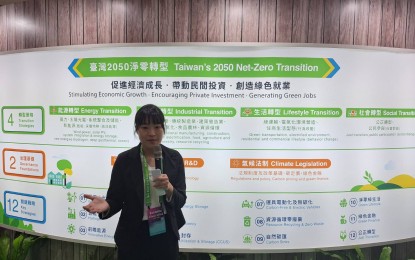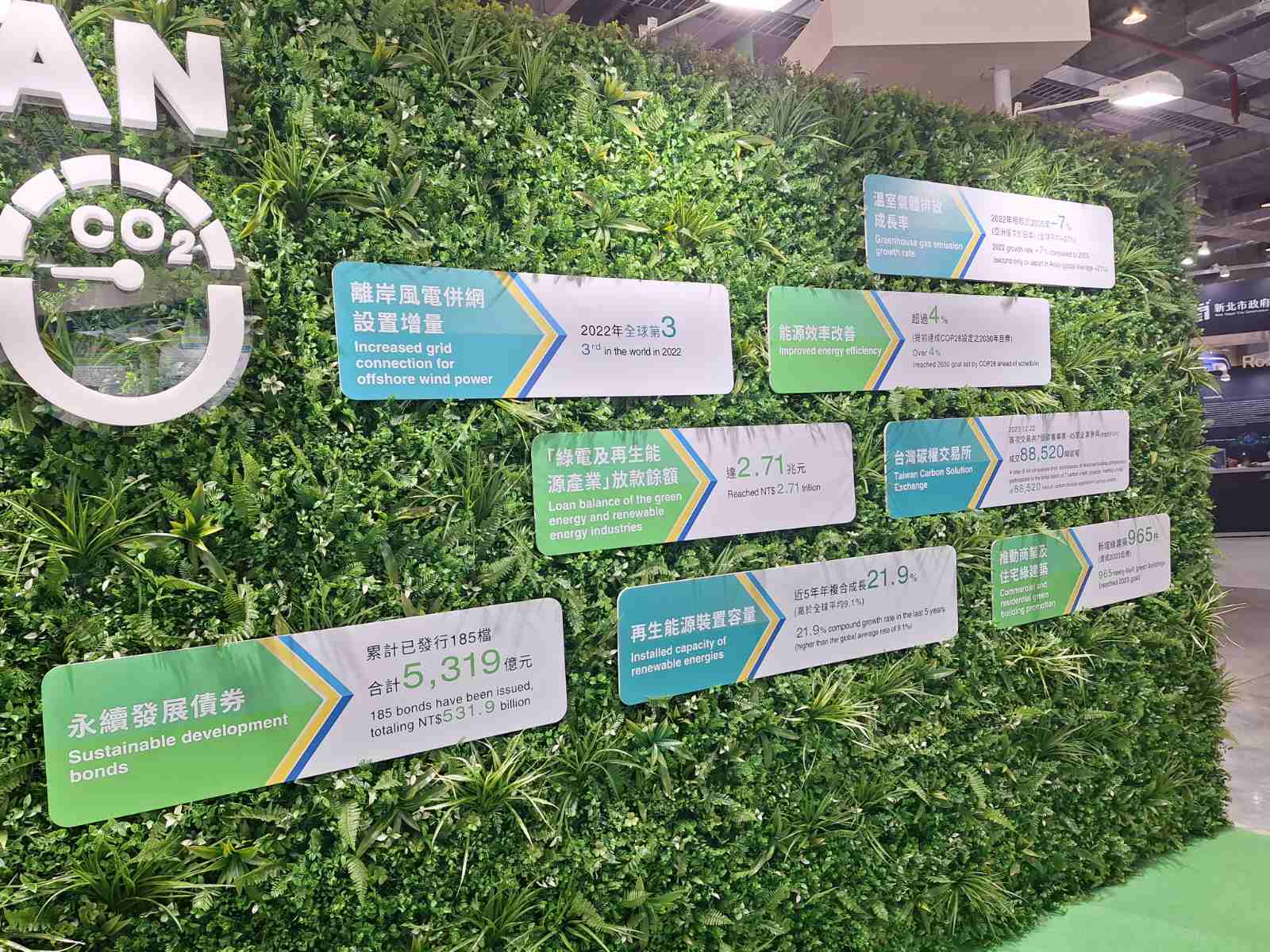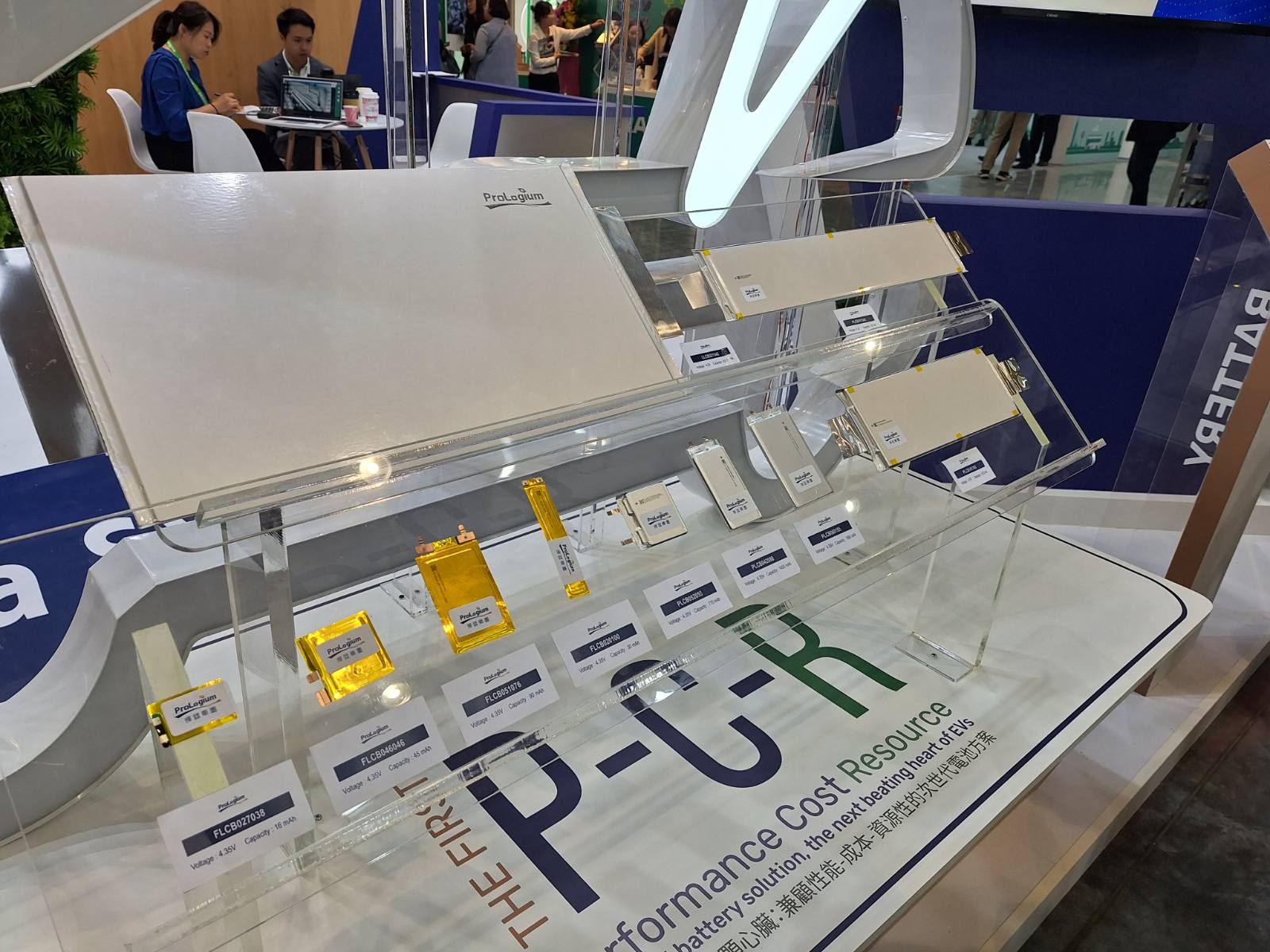
TAKING THE LEAD. A staff member of the National Development Council explains Taiwan's 2050 Net Zero Transition program during the tour for international media practitioners on the sidelines of the 2024 Smart City Summit and Expo (SCSE) at the Taipei Nangang Exhibition Center Hall 2 on March 20, 2024. In March 2022, the island's government officially published “Taiwan’s Pathway to Net-Zero Emissions in 2050”, a blueprint to achieve net zero emissions by 2050 aimed at promoting technology research and development and innovation in key areas, guide the green transition of industry, and spur a new wave of economic growth. (PNA photo by Benj Bondoc)
TAIPEI, Taiwan – Chinese philosopher and Taoism founder Lao Tzu once said, “A journey of a thousand miles begins with a single step.” This proverb proves to be a guiding light for Taiwan in its journey of pursuing innovations and sustainable development through achieving net zero emissions.
Net zero is the state of balance between producing and removing greenhouse gases from the atmosphere.
With this goal in mind, the island is bent on pursuing smart technologies aiming not only to provide better quality of life and convenience for its citizens but also to mitigate the impact of climate change. At the forefront of this goal are the government and the private sector working tirelessly to promote these initiatives both locally and internationally.
During the global tour for international media members at the Taipei Nangang Exhibition Center Hall on March 20 as part of the 2024 Smart City Summit and Expo (SCSE), Taiwan’s National Development Council (NDC) presented the government’s strategies and policies for achieving net zero emissions.
The NDC is the main policy-planning agency of the Executive Yuan, Taiwan’s highest administrative organ, and is responsible for planning, designating, coordinating, reviewing, and evaluating the nation’s overall development.
In March 2022, the government officially published “Taiwan’s Pathway to Net-Zero Emissions in 2050”, a blueprint to achieve the goal by 2050 and is aimed at promoting technology research and development and innovation in key areas, guide the green transition of industry, and spur a new wave of economic growth.
The NDC also looks forward to promoting green financing, increasing investments in various key milestones, and ensuring a reasonable transition period.
The island’s 2050 net-zero emissions pathway is anchored on the four major transition techniques – energy, industrial, lifestyle, and social. It also included two governance foundations – technology research and development (R & D), and climate legislation and is supplemented by “12 Key Strategies”.
These key strategies include wind/solar photovoltaic (PV), hydrogen, innovative energy, power systems and energy storage, energy-saving and efficiency, carbon capture, utilization and storage (CCUS), carbon-free and electric vehicles, resource and recycling zero waste, carbon sinks, green lifestyle, green finance, and just transition.

“2050 Net-Zero Transition" is about environmental sustainability, not only about competitiveness. Only by laying a foundation for long-term growth and stability can we leave behind a better place for future generations,” the NDC said on its website.
By 2030, the government aims to allot close to 900 billion New Taiwan dollars (NTD) (over PHP1.58 trillion) for major plans toward net-zero transition in 2050 in eight key measures – renewables and hydrogen, grid energy and storage, low carbon and negative carbon technology, energy saving and boiler replacement, electrification of transport vehicles, resource circulation, forest carbon sinks, and net-zero living.
These efforts are seen to drive private investments worth over 4 trillion NTD (around PHP7.05 trillion), create 551,000 jobs and a production value of PHP5.9 trillion NTD (around PHP10.41 trillion), decrease the dependence on imported energy from 97.4 percent in 2011 to below 50 percent and reduced air pollution by around 30 percent.
The government, meanwhile, would provide subsidies to households, businesses, and transport stakeholders to raise the efficiency of carbon reduction.
These subsidies are intended for energy-saving and home appliance replacement, business equipment replacement and system energy-saving projects, carbon reduction demonstration in existing buildings, and accelerating vehicle electrification.
Biotechnology, marine ecological protection
The National Taiwan Ocean University, the island’s leader in the fields of sustainable development and environmental protection, also showcased key technologies in various fields such as energy, marine ecological protection, and smart shipping.
These include a floating wind power platform that expands offshore wind fields and enables floating structures to carry larger wind turbines.
The floating platform design emphasizes symmetry by reducing system movement through anchoring and load adjustment to improve power generation efficiency and increase system reliability.
Another key technology is a fixed point absorption wave power generation system which uses a cylindrical floating body and connecting rods. These are used to adapt to the island’s summer and winter sea wave conditions.

This system includes a vertical floating body and an energy transfer system to enhance power generation efficiency.
Meanwhile, Violon Biotech Co. Ltd. showcased its technology featuring industrial carbon capture and biologically accelerating carbon removal and utilization by micro-algae.
Its technology converts carbon dioxide in the hydrosphere to form hydrogen carbonate and then converts it into algae powder through rapid photosynthesis of microalgae. The algae powder is then made to feed for animals, redistributes carbon elements into the biosphere, and stores them in organisms to slow down the return of carbon dioxide to the atmosphere while producing food that is beneficial to humans.
Another project, meanwhile, focuses on finding solutions to the hike in global carbon dioxide emissions.
The project gives a special focus on the carbon sequestration ability of marine organisms, especially seaweed, which can absorb carbon dioxide from the atmosphere and convert it into microbial energy to achieve carbon storage.
Meanwhile, a ship's virtual reality technology combines virtual reality, smart ships, and digital avatar simulation to expand smart shipping applications.
Through the use of realistic port scenes, ship operations are simulated, and practical drills are provided to boost crew skills. This technology also provides data analysis useful in optimizing navigation trajectories, studying the impact of climate and human factors on ship maneuvering, improving maritime safety, and cutting training costs.
Meanwhile, a river coast waste detection and real-time monitoring system uses drones for waste monitoring, monitoring and identification of waste on coasts and rivers, and autonomous cruising beyond visual range.
It applies a deep learning neural network used to identify and classify waste. The inspection data is transmitted to the monitoring station server through wireless communication for the competent authorities to compare the terrain environment images to determine whether it is the source of waste, achieve source control, and reduce land waste.
Another technology features the quick restoration of communications through 5G mobile vehicles and drones during times of war or natural calamities.
The management system quickly deploys emergency lightweight mobile networks. This system combines AI technology to achieve target identification and tracking and uses anti-interference technology to ensure 5G private network communications, allowing combat troops and command centers to obtain real-time battle conditions and improve rapid response and collaborative operations efficiency.
It is especially suitable for disaster or military exercise areas where communication is interrupted to ensure the smoothness and resilience of communication connections.
Going ‘smart’
Among companies focusing on smart city solutions is Hon Hai Technology Group (Foxconn), the largest electronic manufacturing services provider globally, with a market share of 40 percent, covering four major product areas – consumer electronics products, cloud network products, computer terminal products, and components, among others.
In recent years, Foxconn has actively invested in three emerging industries – electric vehicles, digital health, and robotics – as well as in three new technology fields of artificial intelligence, semiconductors, and new-generation communication technology.

The company’s CityGPT platform merges generative artificial intelligence (AI) technology with urban intelligence, which offers a glimpse into the boundless chances of future city development.
The CityGPT’s goal is to provide a shared platform where all systems and individuals can easily connect, share resources, enhance urban life quality, and create new business value.
Among the highlights of the company’s exhibition is the Smart Transportation which featured themes such as CityGPT Electric Bus Wizard, Smart Bus Stops, and Model T Bus Interactive Advertising.
The AI-powered electric buses connect citizens and tourist attractions, providing convenient transportation services. Through this technology, visitors can experience future new media and commercial applications while riding the electric buses.
The smart bus stops, meanwhile, address intelligent passenger needs with interactive transportation information.
Meanwhile, its electric bus management platform offers visualization and summary functions to bus operators which create a more intuitive user interface and simplify management operations. It also assists developers of electric bus management tools in integrating different data sources, including input data from images or videos and smart devices, conductive comprehensive analysis, accelerating feature design and enhancement, and improving operation efficiency through continuous learning AI models.
Aside from established companies, start-up businesses are also being tapped to take an active role in Taiwan’s push for smart city solutions.
Qualcomm, a multinational corporation known for designing and manufacturing semiconductors and wireless telecommunications products based in the United States, has a longstanding collaboration with Taiwan’s information and communications technology (ICT) sector.
In 2019, the company launched the Qualcomm Innovate in Taiwan Challenge (QITC) to support Taiwanese start-ups by providing professional technical support and resources and encouraging them to develop innovative solutions using Qualcomm’s diversified platforms.

Through the initiative, Taiwan’s innovative ideas can be integrated with global resources to further propel the island’s ICT technology industry and start-up sector.
The company also offers a comprehensive incubation program, which includes access to its technology, business coaching, IP training, as well as financial grants and encourages start-ups’ protection of inventions through patent filing.
Some start-ups featured in the QITC are 3drens Inc., which develops a swift ‘software as a service’ (SaaS)-driven transportation system, an intuitive interface and subscription model to achieve streamlining communication for rapid digital integration and expedite the transition from traditional logistics; QT Medical Inc., which focuses on the production of high-quality 12-lead diagnostic electrocardiogram (ECG) for use by healthcare professionals and patients; AiSeed Inc., which specializes in edge computing and innovative vertical take-off and landing aircraft for intelligent unmanned drones, human body recognition technology, machine vision and unmanned driving to provide reliable and cost-effective product intelligence solutions for unmanned drone clients and Smart Tag Inc., which develops the Smart Machine Analysis Rapid Test (SMART) Kit, providing easy and affordable digital transformation to factories.
Electric vehicles (EV) are becoming a game-changer in the pursuit of green and smart transportation, hence the demand for EV batteries to reduce, if not eliminate fuel use.
Founded in 2006, ProLogium Technology is an energy innovation company focused on solid-state battery research, development, and manufacturing, that provides next-generation battery solutions for electric vehicles in consumer markets and industrial applications.
The company introduced its “P-C-R Next Generation Solid State Battery” solution, harmonizing “performance, cost, and resource circularity”, to maximize resource efficiency and cost-effectiveness.

The unique structure of ProLogium solid-state batteries enhances recycling capabilities, addressing the significant challenges posed by conventional lithium-ion battery charging, such as fire and explosion risks and the complexities of dismantling and material recovery.
According to its recycling plan, besides high-value metals, solid electrolytes, silicon anode materials, and conductive materials can also be recycled, thereby achieving greater energy efficiency, minimal pollution, and enhanced resource circulation.
The company plans to continuously enhance manufacturing efficiency at its Taoyuan plant and optimize battery cell design, including increasing energy density and adopting a pure silicon anode to reduce carbon emissions.
This move aims to achieve a 23.2 percent reduction in manufacturing carbon emissions within three years, with a long-term goal of an 83.8 percent reduction over the next decade.
The keys to these achievements for lower-carbon emissions are the adoption of high-efficiency, low-carbon processes and equipment, focusing on sustainable electricity, material sourcing, and building a recycling value chain as part of its expansion strategy.
The methods, practices, and initiatives featured in this year’s SCSE highlight not only how AI and smart technologies can make people’s lives easier and more convenient. These also reflect how innovation and sustainable development can go together toward greener and more resilient communities – a valuable investment for the future that is worthy of emulation by other nations. (PNA)
